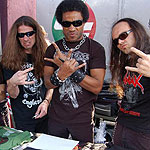I was in Mexico City only a few hours already, a summer Saturday last year, and the first place I wanted to visit was El Chopo. The full name is Tianguis Cultural del Chopo, or the Cultural Open-Air Market of Chopo; Chopo coming from Museo Universitario del Chopo, the name of a building the market used to be near. Markets in Mexico City are sprawling things, not quite formal, not quite informal, often selling goods that are not entirely legal. Each market might tend towards a specialty: food, videos, used furniture, witchcraft, urban flotsam and jetsam. El Chopo's specialty is counterculture. From El Chopo's hundreds of vendors, customers buy goods from a pantheon of music-driven movements: punk, post-punk, goth, prog rock, psychedelia, grunge, emo, death metal, grindcore, et al. Although a kind of wild pluralism is the disorder of the day, at El Chopo black is the color of preference, with the more morbid stuff (punk, goth, emo, death metal) occupying the most space. In the rear of the market, bands play while anarchists hand out pamphlets to the crowd. It's is a singular thing, El Chopo, and in more than twenty-five years it has become a kind of underground institution, a stand-in for Mexican counterculture as a whole.
Like many markets here, most of the goods at El Chopo are pirated. The T-shirts look authentic enough, but you will rarely find a single CD or DVD without the telltale signs of bootlegging. I later realized that all of the music I saw at El Chopo could be found online for cheaper (i.e. free), including the rarest titles. The vendors were probably downloading their titles, along with the fuzzy inkjet-printed covers, from a few dozen MP3 blogs. Like those blogs, the CD selection is permissive–very much so. Alongside Slayer and Gwar CDs one finds albums by Kraftwerk and The Eagles; punk rock and prog rock share tables; and Eric Clapton albums are disconcertingly ubiquitous. The effect is even more jarring when you look at who is browsing. Are these punks and goths really shopping for Pink Floyd and The Beatles? It's as if everyone were in a costume drama listening to music from the wrong era. But very quickly one gets the feeling that the commerce is beside the point. Lots of people are looking, but they're not looking at the bootlegs. They're looking at each other. They're here for the show. They are the show. If El Chopo's CD catalog is all-encompassing, then the fashion is exclusive. On the day I visited, I was one of the few people out of hundreds not studded, vinyled, booted, dyed, or leathered. Even on St. Marks Place in New York–the old St. Marks saturated with punks and junkies and CD shops–I never saw the same military-quality, epic uniformity. There are only five or six groups here, and if you don't belong to any of them, as I don't, then you don't belong.
The entry-level style is metalhead. Because of its simplicity, metalhead is also the most popular: tight black Levis, skull-and-flame-emblazoned tee with band name, long hair, steel-tipped boots, maybe skate sneakers, all topped with a battle-hardened facial expression. Regardless of class or gender, it's the most versatile style, mixing promiscuously with ska, goth, and emo. Metalheads, allowing themselves signs of a civilian life, also meet El Chopo halfway; for most, the style is just a morbid wash. It's easy to imagine most of the metalheads here as weekend warriors: come Monday morning, they'll go to their office jobs, leaving their leather jackets and skull rings safely closeted.
The two other popular looks, goth and punk, require a great deal more fanaticism. Of all the subcultures at El Chopo, the goths and punks put on the show; if they stayed home, so would the rest of us. On an ideological level, a goth's hours spent on personal style make the most sense: goth's ideas are rooted in a kind of undead aristocratism; the style is meant to be out of time and place. Punk, conversely, has aspirations to timeliness. It also occasionally thinks it's political. Of course, it isn't either of these things. Like a character in a supernatural weepy who has unknowingly passed to the afterlife, punk is the last person to know it's dead. Goth, more intelligently, keeps telling us it is dead and it very much wants to stay that way.
The first time I visited the market, I was reminded that uniformity is a gamble for timelessness. Subcultures not only construct a fictitious past (for example, a warped Gothic Romanticism), but also freeze that fiction into a changeless armature of attitudes and beliefs. Subcultures are usually understood as a response to current events, but after their novelty fades, they need to find new hosts in younger generations. This zombielike proliferation has a double dimension in Mexico, one that both places it firmly in the culture and far from it. In Mexico, goth morbidity seamlessly blends into the local morbidity; it is the latest addition to a culture famous for both the Day of the Dead and Santa Muerte. But there is an opposite movement as well, away from the culture, a kind of foreignness beyond what is already sought in the fashion itself. In the United States, fragments of countercultural fashion–tattoos, morbid jewelry, shaved heads–have all been mainstreamed. In the US, subculture inevitably is cannibalized by the culture at large. But in Mexico, the distance between El Chopo's customers and the general populace is greater. It's a reminder that counterculture not only desires a kind of timelessness, but a classlessness as well. Subculture comes to El Chopo in order to be preserved, away from the everyday Mexico, perfectly displayed in a museum of dandified rebellion.
